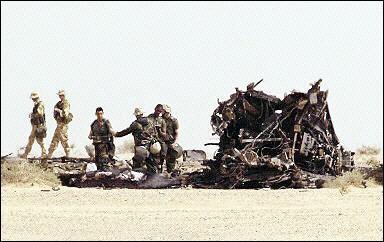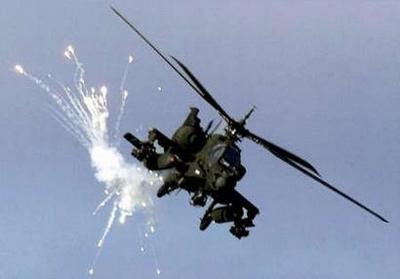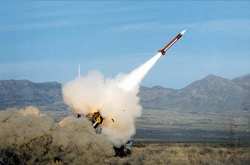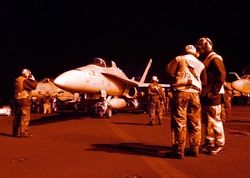Rates "Not Out Of Ordinary"
 A UH-60
Black Hawk helicopter is lost, six known dead. A Super Cobra attack
helicopter crashes in central Iraq, killing two of the Marine
pilots. A CH-46 Sea Knight Marine Corps helicopter crashes. Twelve
dead.
A UH-60
Black Hawk helicopter is lost, six known dead. A Super Cobra attack
helicopter crashes in central Iraq, killing two of the Marine
pilots. A CH-46 Sea Knight Marine Corps helicopter crashes. Twelve
dead.
Taken individually, the news of aviation accidents stemming from
Operation Iraqi Freedom might not look so good. But that would be a
bad assumption, military aviation experts said.
“In no uncertain terms are the rates we’re
experiencing for all types of airframes out of the ordinary,”
said Lt. Col. Benjamin Moody, the executive assistant for the
Marine Corps’ safety division.
“We don’t want to lose any airframe during an
average year, but [the flight hours] coupled with the stressful
environment in which they are operating in Iraq and Kuwait —
this is not necessarily surprising nor particularly
alarming,” he said. “It is very much to the credit of
the pilots and their training and skills that they are not doing
more damage to the aircraft than they are.”

Consider The Total Numbers
With more than 25,000 sorties flown since the war to topple the
Iraqi regime began — roughly 2,000 a day — an overall
mishap rate of aircraft, manned and unmanned, is roughly .05
percent, or less than one in every 1,900 sorties, said Air Force
Tech. Sgt. Brian Orban, a spokesman at the Coalition Forces Air
Component Command in Saudi Arabia. The figure does not include air
missions from aircraft attached to land-based or special operations
forces, he said.
“We’re doing fantastic,” said Marine Col.
David Kerrick, deputy commander of Naval Safety Center in Norfolk
(VA).
The mishap rate for the Navy stands at 2.26 mishaps per 100,000
flight hours, and at 3.48 per 100,000 for the Marine Corps, Kerrick
said. Last year, the rate for the two services combined was 2.28
per 100,000. While the nation’s military was at war in
Afghanistan, pilots did not face the same threats as they do in
Iraq, a nation that possesses the real ability to shoot U.S.
aircraft out of the sky, he said.

Friendly Fire Takes A Toll
The mishaps to date haven’t all been the result of enemy
fire. One aircraft might have been downed by friendly fire.
The Defense Department is investigating the loss of a Navy
F/A-18C Hornet from the USS Kitty Hawk, which might have been shot
down Thursday by a U.S. Patriot missile. “It’s still
under investigation and nothing has been ruled in and ruled out at
this point,” Navy Lt. Herb Josey, a spokesman at Central
Command’s forward headquarters in Qatar said Sunday.
“And the pilot has not been recovered yet.”
 The Army has logged five Class A helicopter
crashes as “accidental” since the end of February, when
American forces were amassing in Kuwait in preparation for the
conflict. Class A accidents are defined as those in which there is
death or permanent disability to the crew and/or the aircraft
sustain damages of $1 million or more.
The Army has logged five Class A helicopter
crashes as “accidental” since the end of February, when
American forces were amassing in Kuwait in preparation for the
conflict. Class A accidents are defined as those in which there is
death or permanent disability to the crew and/or the aircraft
sustain damages of $1 million or more.
Regardless, mishap rates in general have dropped across the
board, and for the Navy and Marine Corps, the rate is down more
than half, from 5.28 per 100,000 flight hours back in 1981, Kerrick
said.
The reasons are many, he said. “We see what the guys and
girls are doing over there in Operation Iraqi Freedom, and
it’s a testament to their training. There has been tremendous
progress made in aircraft reliability and it’s also seen in
the quality of the maintainers,” Kerrick said. “Across
the board in the Navy and Marine Corps, there has been a commitment
to safety … and we’re seeing the results of that.
That’s why they’re doing such a great job.”
It Ain't Easy Flying There
 The pilots face tremendous challenges, from
environmental to psychological, Moody said. “They’re
doing it under the cover of night, wearing night vision goggles,
and there’s a certain amount of natural stress that comes
from just doing the operation they’re doing,” he
said.
The pilots face tremendous challenges, from
environmental to psychological, Moody said. “They’re
doing it under the cover of night, wearing night vision goggles,
and there’s a certain amount of natural stress that comes
from just doing the operation they’re doing,” he
said.
Rising temperatures in Iraq — now into the triple digits
— increases the chance that something could go wrong, Moody
said. “The margin for error becomes narrower and the chance
of having problems, even in normal operations, becomes
greater,” Moody said. “But what we’re seeing is
absolutely more than just luck. … They go through
operations, day by day, flying against bad weather and stress, and
don’t make mistakes. It’s a testament to good
training.”
 ANN's Daily Aero-Linx (05.06.25)
ANN's Daily Aero-Linx (05.06.25) ANN's Daily Aero-Term (05.06.25): Ultrahigh Frequency (UHF)
ANN's Daily Aero-Term (05.06.25): Ultrahigh Frequency (UHF) ANN FAQ: Q&A 101
ANN FAQ: Q&A 101 Classic Aero-TV: Virtual Reality Painting--PPG Leverages Technology for Training
Classic Aero-TV: Virtual Reality Painting--PPG Leverages Technology for Training Airborne 05.02.25: Joby Crewed Milestone, Diamond Club, Canadian Pilot Insurance
Airborne 05.02.25: Joby Crewed Milestone, Diamond Club, Canadian Pilot Insurance







